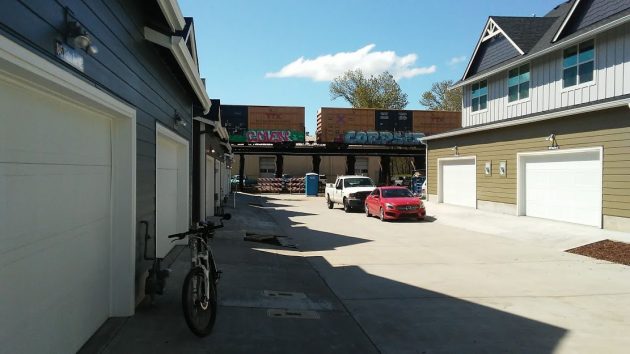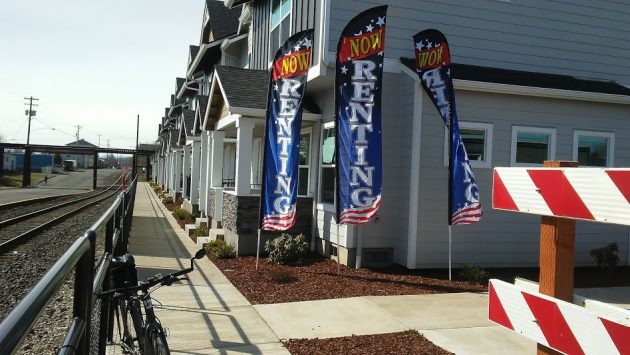
A Portland & Western freight waits on the trestle next to the new Edgewater townhouses on April 5.
Because of its unique location, the Edgewater Village housing complex keeps getting my attention. Not only is it Albany’s first such development on the Willamette River, but it also sits at the over-and-under intersection of two historical rail lines.
And it’s on one of my bike routes through town as well.
As you know, the development of 58 houses and townhouses on a formerly blighted industrial site was launched several years ago with the financial encouragement of the Central Albany Revitalization Area.
Now the last units are about to be finished. Some of them have been sold, and people are beginning to move into the for-rent townhouses. More information on all that is available at developer George Diamond’s website.
As I’ve said, I think the proximity of two rail lines, with one or two slow-moving train movements on each most days, makes the place even more interesting than it already is because of its riverside location and mix of housing types.
If you’re in the neighborhood, on Water Avenue east if Main Street, take a look for yourself. (hh)

The old Oregon Electric rail line on Water Avenue on March 17. In the background, the Toledo Branch trestle, almost 100 years old.

Launched “several years ago”? With “financial encouragement” from CARA? Interesting choice of words and framing, Hasso.
The facts: CARA approved this project back in 2007 and gave the Lake Oswego developer a $2.4 million forgivable loan. And over the past 13 years the project has changed more than a new born baby’s dirty diaper.
58 units / $2,400,000 hand out = $41,379 unearned income to the developer per unit
What a deal given CARA hung a debt around the necks of property taxpayers that now must be serviced with tax revenues skimmed from essential services provided by the other taxing districts (city general fund, county, school fund, etc.).
But, hey, the units sure look nice and the nearby rail lines add a certain ambiance that is hard to achieve without government welfare.
I’ve reported the financial details often and didn’t see the need to reiterate them since they can’t be changed anyway. But I’ve also reported details you left out: The city was faced with a shuttered and burned-out fish processing plant that had become a hangout for vagrants — the very definition of blight. CARA solicited proposals to develop the 6 acres or so. It was not overrun with offers. So it paid for cleaning up the site and eventually enticed a developer. The cost of the cleanup was wrapped into the forgivable loan that was the enticement. Progress on the development was stopped dead by the 2008 depression, and the many changes in the plans since then were the result mainly of city suggestions along with changes in the housing market as it affects that neighborhood. The result now is an increase of close to $12 million (my estimate) in the taxable value of Albany real estate. Maybe Gordon Shadle had a better idea for the mess that was the Inland Quick Freeze property in 2007. But if he did, I don’t remember it. (hh)
I note the rent for the cheapest of the 28 Townhomes STARTS at $1,490/month.
And the 30 houses are priced “mid-high $300s” and “mid $400s”.
Not exactly reachable for the average Albany family.
But the area can now officially be considered gentrified, a haven for affluent people.
And subsidized with public money to the tune of $41,739 per unit.
Are really trying to convince me that this high-end development was the best use of $2,400,000 of taxpayer money? Give…me…a… break.
For whatever reason, you keep trolling. Put your tail between your legs and go whine in your own community…
Unable to present a counterargument based on reason and evidence, Ray instead resorts to stigmatization. An act of exclusion where only local opinions are considered valid.
It’s the easy way out when valid information is presented that challenges a person’s viewpoint.
Thank you for adding your concerns. The piles of gravel that was Stokely Van Camp and it’s cork insulated cold room that became a fish processing plant was an eye sore but it too could have been ground into bits and left in piles until someone wanted that. I am not sure what type of individual seeks a railroad rail for a door step, nor why the railroad forgave the easement for structures so close. When the lights are flashing and bells are ringing you can’t blame the wreck on the train. Yes one day a train will affect that property.
Mr. Gordon L. Shadle, where do you currently live?
Ms J, I don’t think that our host, H. H., places a requirement that you have to live in Albany/Linn Co to post on the blog. And, though biting at times, Mr Shadle brings up some “uncomfortable” points that some people just don’t want to hear or consider. He’s rather knowledgeable in his info ya gotta admit….
Dear Mr. Shadle,
Here is an argument based on reason and evidence.
I am an owner of a home in Edgewater village.
My property taxes last year were $4262.
A quick survey of tax records available for phase 1 of the development show an average charge of $4183 per year in property taxes. If we conservatively assign that value to each of the 30 freestanding homes and estimate $3000 per year for each of the 28 townhomes, that comes to $209,490 per year in property taxes to be collected for the entire development yearly. Considering about $200,000 has been collected so far from the early phase homes, it will take about 10.5 years for the community to see a full return on CARA’s investment. And in the mean time, there are nice homes there on the Dave Clark Trail instead of a hazardous broken-down property.
And the trains generally only run at night.
When I’ve campaigned in the area for City Councilman over the last 40 years, i’ve asked if the train noise was bothersome. Most said either they didn’t hear it or they liked it.
I’ve lived right next the intersection of water and hill for over half a decade. The trains noise wasn’t that bad until after they put the crossing bars in. Now they are legally required to blow the horn at the intersection. Not enough of a nuisance to move away but definitely a noticeable change.